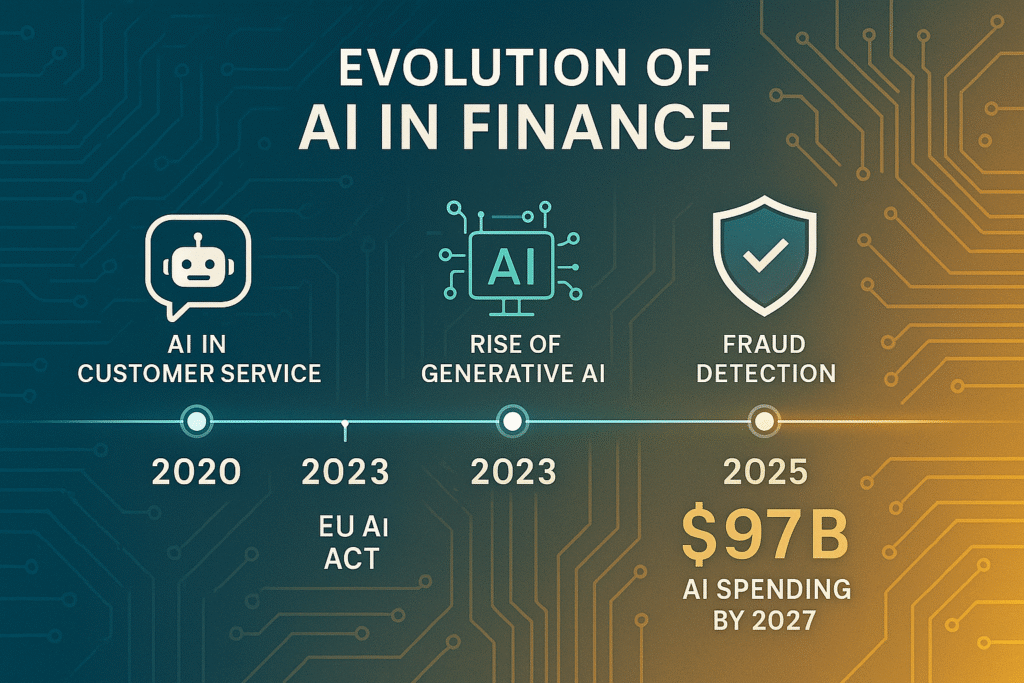Introduction: The AI-Powered Financial Frontier
Imagine a world where your bank predicts your financial needs before you do, or your investments are optimized by algorithms that learn faster than any human. This isn’t science fiction—it’s the reality of Artificial Intelligence in Finance in 2025. From hyper-personalized customer experiences to fraud detection that outsmarts criminals, AI is no longer a buzzword but a cornerstone of the financial industry. As someone who’s tracked tech trends for years, I’ve seen AI evolve from a niche tool to a game-changer that’s rewriting the rules of wealth creation. In this post, we’ll dive into the latest advancements, uncover unique insights, and explore how AI is shaping the future of finance with a fresh perspective. For more info, read our latest blog post
How Artificial Intelligence in Finance is Evolving in 2025
The financial sector has always been data-driven, but AI has taken it to new heights. According to a 2024 report by the Financial Stability Board, AI adoption in finance has surged, with applications spanning customer service, risk management, and algorithmic trading. Furthermore, financial institutions are projected to double their AI spending to $97 billion by 2027, growing at a 29% compound annual rate—the fastest among major industries (IMF, 2023).
Why the rush? AI’s ability to process vast datasets, predict outcomes, and automate tasks is transforming how money moves. However, it’s not just about efficiency; it’s about creating value in ways we couldn’t imagine a decade ago. Let’s break down the key areas where AI is making waves.
Top Applications of AI in Finance Today
Hyper-Personalized Customer Experiences with AI
Gone are the days of one-size-fits-all banking. For example, AI-powered chatbots like Capital One’s Eno use natural language processing to offer 24/7 financial advice, detect fraud, and even warn users about subscription price hikes (eMarketer, 2022). In 2025, generative AI takes this further by crafting tailored investment plans based on your spending habits, life goals, and risk tolerance.
Personal Insight: As a freelancer, I’ve used AI-driven budgeting apps that analyze my irregular income and suggest savings strategies. It’s like having a financial advisor who never sleeps—and doesn’t charge hourly rates. Learn more about budgeting tools in our personal finance tips.
AI in Finance: Revolutionizing Fraud Detection
AI’s real-time data analysis is a game-changer for security. Tools like those used by U.S. Bank leverage deep learning to spot “bad actors” in anti-money laundering efforts, doubling the efficiency of traditional systems (eMarketer, 2022). Moreover, in 2025, generative AI is enhancing fraud detection by simulating attack scenarios, helping banks stay ahead of cybercriminals.

Table: AI in Fraud Detection vs. Traditional Methods
| Aspect | AI-Powered Detection | Traditional Methods |
|---|---|---|
| Speed | Real-time analysis | Delayed, manual reviews |
| Accuracy | 95%+ detection rate | 70-80% detection rate |
| Scalability | Handles billions of transactions | Limited by human resources |
| Cost Efficiency | Reduces operational costs by 30% | High labor costs |
Source: EY, 2024
Algorithmic Trading Powered by Artificial Intelligence in Finance
Hedge funds have used AI for over a decade, but generative AI is leveling the playing field. Nearly half of hedge funds now use tools like ChatGPT for summarizing reports, while advanced models predict market trends with unprecedented accuracy (IMF, 2023). Consequently, in 2025, retail investors are tapping AI platforms to mimic these strategies, democratizing wealth creation.
Unique Insight: The August 2024 selloff in Japanese and U.S. equity markets highlighted AI’s double-edged sword. Sophisticated algorithms amplified volatility by reacting in unison, raising questions about market stability (IMF, 2024). This underscores the need for human oversight to balance AI’s speed with strategic judgment.
Streamlining Financial Reporting with AI
AI is streamlining financial reporting by automating data extraction and validation. A 2024 study found that firms using AI in audits had fewer restatements and SEC inquiries, especially in large corporations with extensive document repositories (DFIN, 2024). Additionally, generative AI prompts are drafting reports and ensuring compliance with evolving regulations, saving time and reducing errors.
Stat: 97% of financial reporting leaders plan to increase generative AI use by 2028 (DFIN, 2024).
Challenges of Using Artificial Intelligence in Finance
While AI’s potential is immense, it’s not without pitfalls. Here are the key challenges shaping the conversation in 2025:
- Data Privacy and Bias: AI models can inadvertently perpetuate biases in historical data, leading to unfair credit scoring or loan denials. The CFPB emphasizes that AI-driven fraud screening must comply with laws like the Fair Credit Reporting Act to protect consumers.
Cybersecurity Risks in AI-Driven Finance
- Cybersecurity Threats: AI lowers the barrier for cybercriminals, enabling sophisticated phishing attacks and deepfakes (ECB, 2024). Therefore, financial institutions must invest in AI-powered defenses to counter these risks.
Regulatory Gaps and Ethical Concerns
- Regulatory Gaps: The rapid pace of AI adoption outstrips existing frameworks. The EU AI Act aims to address this, but global coordination remains a challenge (FSB, 2024).
Personal Perspective: As someone who values transparency, I worry about “black box” AI models that make decisions without explainability. Firms like EY are tackling this with platforms like EY.ai, which prioritize ethical development (EY, 2024).
The Future of Artificial Intelligence in Finance
Looking ahead, Artificial Intelligence in Finance is poised for exponential growth. Here are three trends to watch in 2025 and beyond:

Decentralized Finance and AI Integration
- Decentralized Finance (DeFi) and AI: Posts on X highlight AI-powered agents executing trades and creating smart contracts in DeFi, blending blockchain and AI for a new financial paradigm (@Abdullah7zr, 2025).
Advanced Market Simulations with AI
- Agent-Based Modeling: Advanced simulations like agent-based modeling will help regulators understand AI’s impact on market stability, reducing systemic risks (PMC, 2025).
AI for Sustainable Finance
- Sustainability Integration: AI is aligning with ESG (Environmental, Social, Governance) goals, optimizing green investments and ensuring compliance with sustainability regulations (EY, 2024).
Infographic Idea: Visualize AI’s impact with a timeline showing milestones (e.g., ChatGPT’s 2022 launch, EU AI Act 2024) and future predictions (e.g., $400B AI market by 2027).
Conclusion: Embracing AI in Finance Responsibly
Artificial Intelligence in Finance is more than a trend—it’s a revolution that’s democratizing wealth, enhancing security, and reshaping markets. However, with great power comes great responsibility. As we navigate 2025, financial institutions must balance innovation with ethics, ensuring AI serves consumers without compromising trust. My journey with AI tools has shown me their potential to simplify complex decisions, but human judgment remains irreplaceable.
Call-to-Action: What’s your take on AI’s role in finance? Are you excited about its possibilities or cautious about its risks? Share your thoughts in the comments, explore our related posts on finance, or subscribe for weekly insights on the future of finance. Let’s shape this AI-driven world together!
